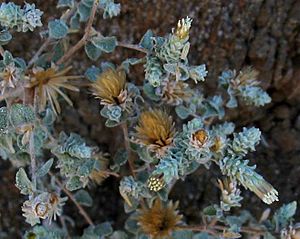Nevin's brickellbush facts for kids
Quick facts for kids Brickellia nevinii |
|
|---|---|
 |
|
| Scientific classification | |
| Kingdom: | |
| (unranked): | |
| (unranked): | |
| (unranked): | |
| Order: | |
| Family: | |
| Subfamily: |
Asteroideae
|
| Tribe: |
Eupatorieae
|
| Genus: |
Brickellia
|
| Species: |
B. nevinii
|
| Binomial name | |
| Brickellia nevinii |
|
| Synonyms | |
|
Coleosanthus nevinii (A.Gray) A.Heller |
|
Brickellia nevinii is a type of flowering plant. It is often called Nevin's brickellbush. This plant belongs to the daisy family. You can find it growing in southern California and Nevada. It is not very common there. It lives in desert and mountain areas.
Contents
What Does Nevin's Brickellbush Look Like?
Nevin's brickellbush is a tall shrub. It can grow to be about 3 to 5 meters high. That's like a small tree! Its branches are thick and tangled. The whole plant, including its leaves, is covered in soft, gray, woolly fibers.
Leaves and Flowers
The leaves of this plant are small. They are shaped like an oval or a heart. Their edges have small teeth. Most leaves are less than two centimeters long.
The plant produces many flower heads. These grow in groups or clusters. Each flower head is about 1.5 centimeters long. They are shaped like a cylinder or a cone. Layers of gray, woolly phyllaries wrap around the flower head. These phyllaries are like small leaves that protect the flowers. Their tips curl outwards from the head.
Inside each flower head, there are about 23 small flowers. These are called disc florets. They can be dull white or yellowish with a hint of red. They stick out from the top of the flower head.
Fruit and Seeds
After the flowers bloom, the plant makes fruit. The fruit is a small, hairy achene. It is about 4 millimeters long. An achene is a type of dry fruit that holds one seed. This fruit has a pappus of bristles. A pappus is a feathery or hairy part. It helps the seeds float away in the wind.
Who Was Nevin's Brickellbush Named After?
This plant was named after a person named Rev. Joseph Cook Nevin. He was a reverend. He was also interested in plants. He helped discover and study many different plant species.

